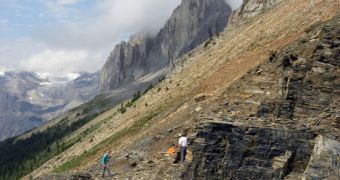Researchers are positively thrilled at the discovery of a new fossil-rich dig site, which is located very close to the famous Burgess Shale.
If the new location yields just half or a quarter the number of creatures discovered in the former, than its finding could be cataloged as an important success.
The Burgess Shale has been known for more than a century as a critical source of fossils of soft-bodied organisms, which are very difficult to find anywhere else.
It could be that the new site, located just some 40 kilometers from the Shale, could include the same type of fossils, which could contribute to advance science considerably.
The Burgess-like fossils were discovered in the valley of the Stanley Glacier in Kootenay National Park, by a team of Canadian experts led by paleontologist Jean-Bernard Caron of the Royal Ontario Museum, in Toronto.
The researchers report in the September issue of the respected scientific journal Geology that the fossils they discovered high in the Canadian Rockies could be related to the ones found in the Shale.
Both structures contain fossils that date back to about 505 million years ago, to a time when the Earth recorded its first “species Big Bang,” Wired reports.
The number of species living on the planet exploded around that time, leading to an impressive biodiversity that still puzzles evolutionary biologists to this day.
The soft-bodied critters that are found in the Shale and the new location most likely scurried the ocean floor all those eons ago, when they were buried under the mud by landslides, and preserved for eternity.
“This new locality adds to our knowledge of the environments where these organisms lived and died and thus adds important context,” explains Imperial College London (ICL) geoscientist Peter Allison.
“We consider it likely that future exploration and study will continue to yield new taxa from the ‘thin’ Stephen Formation, which is exposed over a broader area regionally than the ‘thick’ Stephen Formation,” researchers who have had a chance to look at the new formation say.
Already, scientists have begun producing new data on a variety of species, which have thus far been discovered to exist only in the Shale.
As more and more organisms and fossils are discovered in the Stephen Formation, scientists will undoubtedly begin to dig even deeper into the exposed rock layers, in search for the rarest remains.

 14 DAY TRIAL //
14 DAY TRIAL //